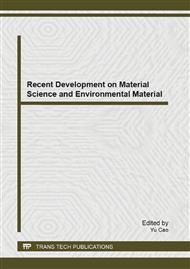p.312
p.317
p.321
p.325
p.330
p.336
p.341
p.345
p.351
Effect of Hydraulic Classification on Iron Ore Tailings Preparing High Strength Construction Materials
Abstract:
The aim of this study is to understand the effect of hydraulic classification on the iron ore tailings, and develop the cementitious activity of tailings to prepare construction materials. It was indicated that hydraulic classification can effectively divide the particulates of tailings into coarse and fine powders. The compression strength of the prepared construction materials are 87.83 MPa at 28 days, which have higher strength than the construction materials using original tailing, The variation in the tailings samples after hydraulic classification and the cementitious material after step-milling was characterized by sieve analysis, complete chemical analysis, scanning electron microscopy (SEM), and the particles size distribution. By mechanical properties testing and microstructure analysis shows that after hydraulic classification of tailings under the same conditions, the strength of the 3 days, 7 days, 28 days are higher than that of the original tailings. The main phases in the system are the rod of ettringite and low crystallinity or the amorphous C-S-H gel, and residual Ca(OH)2.
Info:
Periodical:
Pages:
330-335
Citation:
Online since:
September 2013
Authors:
Price:
Сopyright:
© 2013 Trans Tech Publications Ltd. All Rights Reserved
Share:
Citation:


